Enhanced Thermal Properties of Zirconia Nanoparticles and Chitosan-Based Intumescent Flame Retardant Coatings
Abstract
:1. Introduction
2. Materials and Methods
2.1. Materials
2.2. Synthesis of ZrO2 NPs
2.3. Characterization
2.4. Preparation of Epoxy Flame Retardant Coatings Using ZrO2 NPs
2.5. Characterization of Flame Retardant Coating Formulations Using FT-IR
2.6. Flammability, Combustion, and Thermal Characteristics of Flame Retardant Coatings
2.7. Morphology of Char Residues
3. Results and Discussion
3.1. XRD Pattern of ZrO2 NPs
3.2. SEM Analysis of ZrO2 NPs
3.3. TEM Analysis of ZrO2 NPs
3.4. EDS Analysis of ZrO2 NPs
3.5. FT-IR Analysis of ZrO2 NPs
3.6. Characterization of Flame-Retardant Coating Formulations Using FT-IR
3.7. Characterization of Flame-Retardant Coating Formulations Using XRD
3.8. Flammability Tests
The Limit of Oxygen Index (LOI) and UL-94V
3.9. Combustion Test
3.10. Thermal Stability Test
3.11. Char Morphology Analysis Flame Retardant Coatings
3.11.1. SEM Analysis
3.11.2. EDS Analysis
4. Conclusions
Author Contributions
Funding
Conflicts of Interest
References
- Giúdice, C.; Benítez, J. Zinc borates as flame-retardant pigments in chlorine-containing coatings. Prog. Org. Coat. 2001, 42, 82–88. [Google Scholar] [CrossRef]
- Minegishi, S.; Tsuchida, S.; Sasaki, M.; Kameyama, A.; Kudo, H.; Nishikubo, T. Synthesis of polyphosphonates containing pendant chloromethyl groups by the polyaddition of bis (oxetane) s with phosphonic dichlorides. J. Polym. Sci. Part A Polym. Chem. 2002, 40, 3835–3846. [Google Scholar] [CrossRef]
- Toldy, A.; Szolnoki, B.; Marosi, G. Flame retardancy of fibre-reinforced epoxy resin composites for aerospace applications. Polym. Degrad. Stab. 2011, 96, 371–376. [Google Scholar] [CrossRef]
- Ahmad, T.; Ahmad, M.S.T. Hydrothermal Synthesis, Characterization and Dielectric Properties of Zirconia Nanoparticles. Mater. Sci. Eng. Int. J. 2017. [Google Scholar] [CrossRef]
- Ajith, A.; Xian, G.; Li, H.; Sheriff, Z.; Thomas, S. Surface grafting of flax fibers with hydrous zirconia nanoparticles and the effects on the tensile and bonding properties. J. Compos. Mater. 2016, 50, 627–635. [Google Scholar] [CrossRef]
- Arreche, R.; Bellotti, N.; Blanco, M.; Vázquez, P. Synthesis and Characterization of Zirconium Oxides for Use as Antimicrobial Additives in Paints. Procedia Mater. Sci. 2015, 9, 627–634. [Google Scholar] [CrossRef] [Green Version]
- Behbahani, A.; Rowshanzamir, S.; Esmaeilifar, A. Hydrothermal Synthesis of Zirconia Nanoparticles from Commercial Zirconia. Procedia Eng. 2012, 42, 908–917. [Google Scholar] [CrossRef] [Green Version]
- Basahel, S.N.; Ali, T.T.; Mokhtar, M.; Narasimharao, K. Influence of crystal structure of nanosized ZrO2 on photocatalytic degradation of methyl orange. Nanoscale Res. Lett. 2015, 10, 113. [Google Scholar] [CrossRef]
- Ehrlich, H.; Simon, P.; Motylenko, M.; Wysokowski, M.; Bazhenov, V.V.; Galli, R.; Stelling, A.L.; Stawski, D.; Ilan, M.; Stöcker, H.; et al. Extreme Biomimetics: Formation of zirconium dioxide nanophase using chitinous scaffolds under hydrothermal conditions. J. Mater. Chem. B 2013, 1, 5092–5099. [Google Scholar] [CrossRef]
- Bumajdad, A.; Nazeer, A.A.; Al Sagheer, F.; Nahar, S.; Zaki, M.I. Controlled Synthesis of ZrO2 Nanoparticles with Tailored Size, Morphology and Crystal Phases via Organic/Inorganic Hybrid Films. Sci. Rep. 2018, 8, 3695. [Google Scholar] [CrossRef]
- Eshed, M.; Pol, S.; Gedanken, A.; Balasubramanian, M. Zirconium nanoparticles prepared by the reduction of zirconium oxide using the RAPET method. Beilstein J. Nanotechnol. 2011, 2, 198–203. [Google Scholar] [CrossRef] [Green Version]
- Fathima, J.B.; Pugazhendhi, A.; Venis, R. Synthesis and characterization of ZrO2 nanoparticles-antimicrobial activity and their prospective role in dental care. Microb. Pathog. 2017, 110, 245–251. [Google Scholar] [CrossRef]
- Jayakumar, S.; Ananthapadmanabhan, P.; Perumal, K.; Thiyagarajan, T.; Mishra, S.; Su, L.; Tok, A.; Guo, J. Characterization of nano-crystalline ZrO2 synthesized via reactive plasma processing. Mater. Sci. Eng. B 2011, 176, 894–899. [Google Scholar] [CrossRef]
- Maridurai, T.; Balaji, D.; Sagadevan, S. Synthesis and Characterization of Yttrium Stabilized Zirconia Nanoparticles. Mater. Res. 2016, 19, 812–816. [Google Scholar] [CrossRef] [Green Version]
- Precious-Ayanwale, A.; Donohue-Corenjo, A.; Cuevas-Gonzalex, J.C.; Espinosa-Cristobal, L.F.; Reyes-Lopez, S.Y. Review of The Synthesis, Characterization, and Application of Zirconia Mixed Metal Oxide Nanoparticles. Int. J. Res. 2018, 6, 136–145. [Google Scholar]
- Tyagi, B.; Sidhpuria, K.; Shaik, B.; Jasra, R.V. Synthesis of Nanocrystalline Zirconia Using Sol−Gel and Precipitation Techniques. Ind. Eng. Chem. Res. 2006, 45, 8643–8650. [Google Scholar] [CrossRef]
- Siddiqui, M.R.H.; Al-Wassil, A.I.; Al-Otaibi, A.M.; Mahfouz, R.M. Effects of precursor on the morphology and size of ZrO2 nanoparticles. synthesized by sol-gel method in a non-aqueous medium. Mater. Res. 2012, 15, 986–989. [Google Scholar] [CrossRef]
- Rauta, P.; Manivasakan, P.; Rajendran, V.; Sahu, B.; Panda, B.; Mohapatra, P. Phase transformation of ZrO2 nanoparticles produced from zircon. Phase Transit. 2012, 85, 13–26. [Google Scholar] [CrossRef]
- Negahdary, M.; Habibi-Tamijani, A.; Asadi, A.; Ayati, S. Synthesis of Zirconia Nanoparticles and Their Ameliorative Roles as Additives Concrete Structures. J. Chem. 2013, 2013, 314862. [Google Scholar] [CrossRef]
- Dzyazko, Y.S.; Volfkovich, Y.M.; Sosenkin, V.E.; Nikolskaya, N.F.; Gomza, Y.P. Composite inorganic membranes containing nanoparticles of hydrated zirconium dioxide for electrodialytic separation. Nanoscale Res. Lett. 2014, 9, 271. [Google Scholar] [CrossRef] [Green Version]
- Battegazzore, D.; Alongi, J.; Fontaine, G.; Frache, A.; Bourbigot, S.; Malucelli, G. Bulk vs. surface flame retardancy of fully bio-based polyamide 10, 10. RSC Adv. 2015, 5, 39424–39432. [Google Scholar] [CrossRef]
- Liu, X.; Guo, J.; Sun, J.; Gu, X.; Feng, W.; Liu, W.; Li, H.; Zhang, S. The preparation of a bisphenol A epoxy resin based ammonium polyphosphate ester and its effect on the char formation of a fire-resistant transparent coating. Prog. Org. Coat. 2019, 129, 349–356. [Google Scholar] [CrossRef]
- Shi, Y.; Wang, G. The novel epoxy/PEPA phosphate flame retardants: Synthesis, characterization and application in transparent intumescent fire resistant coatings. Prog. Org. Coat. 2016, 97, 1–9. [Google Scholar] [CrossRef]
- Shi, Y.; Wang, G. The novel silicon-containing epoxy/PEPA phosphate flame retardant for transparent intumescent fire resistant coating. Appl. Surf. Sci. 2016, 385, 453–463. [Google Scholar] [CrossRef]
- Da Silveira, M.R.; Peres, R.S.; Moritz, V.F.; Ferreira, C.A. Intumescent Coatings Based on Tannins for Fire Protection. Mater. Res. 2019, 22. [Google Scholar] [CrossRef]
- Ullah, S.; Ahmad, F. Effects of zirconium silicate reinforcement on expandable graphite based intumescent fire retardant coating. Polym. Degrad. Stab. 2014, 103, 49–62. [Google Scholar] [CrossRef]
- Xing, W.; Zhang, P.; Song, L.; Wang, X.; Hu, Y. Effects of alpha-zirconium phosphate on thermal degradation and flame retardancy of transparent intumescent fire protective coating. Mater. Res. Bull. 2014, 49, 1–6. [Google Scholar] [CrossRef]
- Aziz, H.; Ahmad, F.; Zia-ul-Mustafa, M. Effect of Titanium Oxide on Fire Performance of Intumescent Fire Retardant Coating. Adv. Mater. Res. 2104, 935, 224–228. [Google Scholar] [CrossRef]
- Wang, Z.; Han, E.; Liu, F.; Ke, W. Fire and Corrosion Resistances of Intumescent Nano-coating Containing Nano-SiO2 in Salt Spray Condition. J. Mater. Sci. Technol. 2010, 26, 75–81. [Google Scholar] [CrossRef]
- Xu, B.; Wu, X.; Ma, W.; Qian, L.; Xin, F.; Qiu, Y. Synthesis and characterization of a novel organic-inorganic hybrid char-forming agent and its flame-retardant application in polypropylene composites. J. Anal. Appl. Pyrolysis 2018, 134, 231–242. [Google Scholar] [CrossRef]
- Yan, L.; Xu, Z.; Wang, X. Synergistic effects of organically modified montmorillonite on the flame-retardant and smoke suppression properties of transparent intumescent fire-retardant coatings. Prog. Org. Coat. 2018, 122, 107–118. [Google Scholar] [CrossRef]
- Yang, Z.; Peng, H.; Wang, W.; Liu, T. Crystallization behavior of poly (ε-caprolactone)/layered double hydroxide nanocomposites. J. Appl. Polym. Sci. 2010, 116, 2658–2667. [Google Scholar] [CrossRef]
- Gillani, Q.F.; Ahmad, F.; Mutalib, M.I.A.; Megat-Yusoff, P.S.M.; Ullah, S. Effects of Halloysite Nanotube Reinforcement in Expandable Graphite Based Intumescent Fire Retardant Coatings Developed Using Hybrid Epoxy Binder System. Chin. J. Polym. Sci. Engl. Ed. 2018, 36, 1286–1296. [Google Scholar] [CrossRef]
- Liu, X.Q.; Wang, D.Y.; Wang, X.L.; Chen, L.; Wang, Y.Z. Synthesis of functionalized α-zirconium phosphate modified with intumescent flame retardant and its application in poly (lactic acid). Polym. Degrad. Stab. 2013, 98, 1731–1737. [Google Scholar] [CrossRef]
- Lu, H.; Wilkie, C.A.; Ding, M.; Song, L. Thermal properties and flammability performance of poly (vinyl alcohol)/α-zirconium phosphate nanocomposites. Polym. Degrad. Stab. 2011, 96, 885–891. [Google Scholar] [CrossRef]
- Alongi, J.; Frache, A. Flame retardancy properties of α-zirconium phosphate based composites. Polym. Degrad. Stab. 2010, 95, 1928–1933. [Google Scholar] [CrossRef]
- Yang, D.; Hu, Y.; Song, L.; Nie, S.; He, S.; Cai, Y. Catalyzing carbonization function of α-ZrP based intumescent fire retardant polypropylene nanocomposites. Polym. Degrad. Stab. 2008, 93, 2014–2018. [Google Scholar] [CrossRef]
- Li, K.; Lei, H.; Zeng, X.; Li, H.; Lai, X.; Chai, S. Preparation of a flame retardant phosphorus-containing polyacrylate/α-zirconium phosphate nanocomposite through: In situ emulsion polymerization. RSC Adv. 2017, 7, 49290–49298. [Google Scholar] [CrossRef]
- Liu, Q.; Song, L.; Lu, H.; Hu, Y.; Wang, Z.; Zhou, S. Study on combustion property and synergistic effect of intumescent flame retardant styrene butadiene rubber with metallic oxides. Polym. Adv. Technol. 2009, 20, 1091–1095. [Google Scholar] [CrossRef]
- Ullah, S.; Ahmad, F.; Shariff, A.M.; Bustam, M.A.; Gonfa, G.; Gillani, Q.F. Effects of ammonium polyphosphate and boric acid on the thermal degradation of an intumescent fire retardant coating. Prog. Org. Coat. 2017, 109, 70–82. [Google Scholar] [CrossRef]
- Zheng, Z.; Liu, Y.; Zhang, L.; Dai, B.; Yang, X.; Wang, H. Fabrication of halogen-free ammonium phosphate with two components via a simple method and its flame retardancy in polypropylene composites. J. Therm. Anal. Calorim. 2017, 127, 2013–2023. [Google Scholar] [CrossRef]
- Shao, Z.B.; Deng, C.; Tan, Y.; Yu, L.; Chen, M.J.; Chen, L.; Wang, Y.Z. Ammonium polyphosphate chemically-modified with ethanolamine as an efficient intumescent flame retardant for polypropylene. J. Mater. Chem. A 2014, 2, 13955–13965. [Google Scholar] [CrossRef]
- Abdeen, Z.; Mohammad, S.G.; Mahmoud, M. Adsorption of Mn (II) ion on polyvinyl alcohol/chitosan dry blending from aqueous solution. Environ. Nanotechnol. Monit. Manag. 2015, 3, 1–9. [Google Scholar] [CrossRef] [Green Version]
- Mohanasrinivasan, V.; Mishra, M.; Paliwal, J.S.; Singh, S.K.; Selvarajan, E.; Suganthi, V.; Subathra Devi, C. Studies on heavy metal removal efficiency and antibacterial activity of chitosan prepared from shrimp shell waste. 3 Biotech 2014, 4, 167–175. [Google Scholar] [CrossRef] [PubMed]
- Kumar, S.; Koh, J. Physiochemical, Optical and Biological Activity of Chitosan-Chromone Derivative for Biomedical Applications. Int. J. Mol. Sci. 2012, 13, 6102–6116. [Google Scholar] [CrossRef] [Green Version]
- Sangeetha, V.; Kanagathara, N.; Sumathi, R.; Sivakumar, N.; Anbalagan, G. Spectral and Thermal Degradation of Melamine Cyanurate. J. Mater. 2013, 2013, 262094. [Google Scholar] [CrossRef]
- Coşkuner, B.; Figen, A.K.; Piskin, M.B. The use of boric acid (H3BO3) and boron oxide (B2O3) for co-precipitation synthesis of cobalt-boron catalysts: Catalytic activity in hydrogen generation. Kinet. Catal. 2014, 55, 809–823. [Google Scholar] [CrossRef]
- Gillani, Q.F.; Ahmad, F.; Mutalib, M.A.; Megat-Yusoff, P.S.; Ullah, S.; Messet, P.J.; Zia-Ul-Mustafa, M. Thermal degradation and pyrolysis analysis of zinc borate reinforced intumescent fire retardant coatings. Prog. Org. Coat. 2018, 123, 82–98. [Google Scholar] [CrossRef]
- Jimenez, M.; Guin, T.; Bellayer, S.; Dupretz, R.; Bourbigot, S.; Grunlan, J.C. Microintumescent mechanism of flame-retardant water-based chitosan-ammonium polyphosphate multilayer nanocoating on cotton fabric. J. Appl. Polym. Sci. 2016, 133. [Google Scholar] [CrossRef]
- Fang, F.; Zhang, X.; Meng, Y.; Gu, Z.; Bao, C.; Ding, X.; Li, S.; Chen, X.; Tian, X. Intumescent flame retardant coatings on cotton fabric of chitosan and ammonium polyphosphate via layer-by-layer assembly. Surf. Coat. Technol. 2015, 262, 9–14. [Google Scholar] [CrossRef]
- Carosio, F.; Alongi, J. Flame Retardant Multilayered Coatings on Acrylic Fabrics Prepared by One-Step Deposition of Chitosan/Montmorillonite Complexes. Fibers 2018, 6, 36. [Google Scholar] [CrossRef]
- Gao, Y.; Wang, Q.; Lin, W. Ammonium Polyphosphate Intercalated Layered Double Hydroxide and Zinc Borate as Highly Efficient Flame Retardant Nanofillers for Polypropylene. Polymers 2018, 10, 1114. [Google Scholar] [CrossRef] [PubMed]
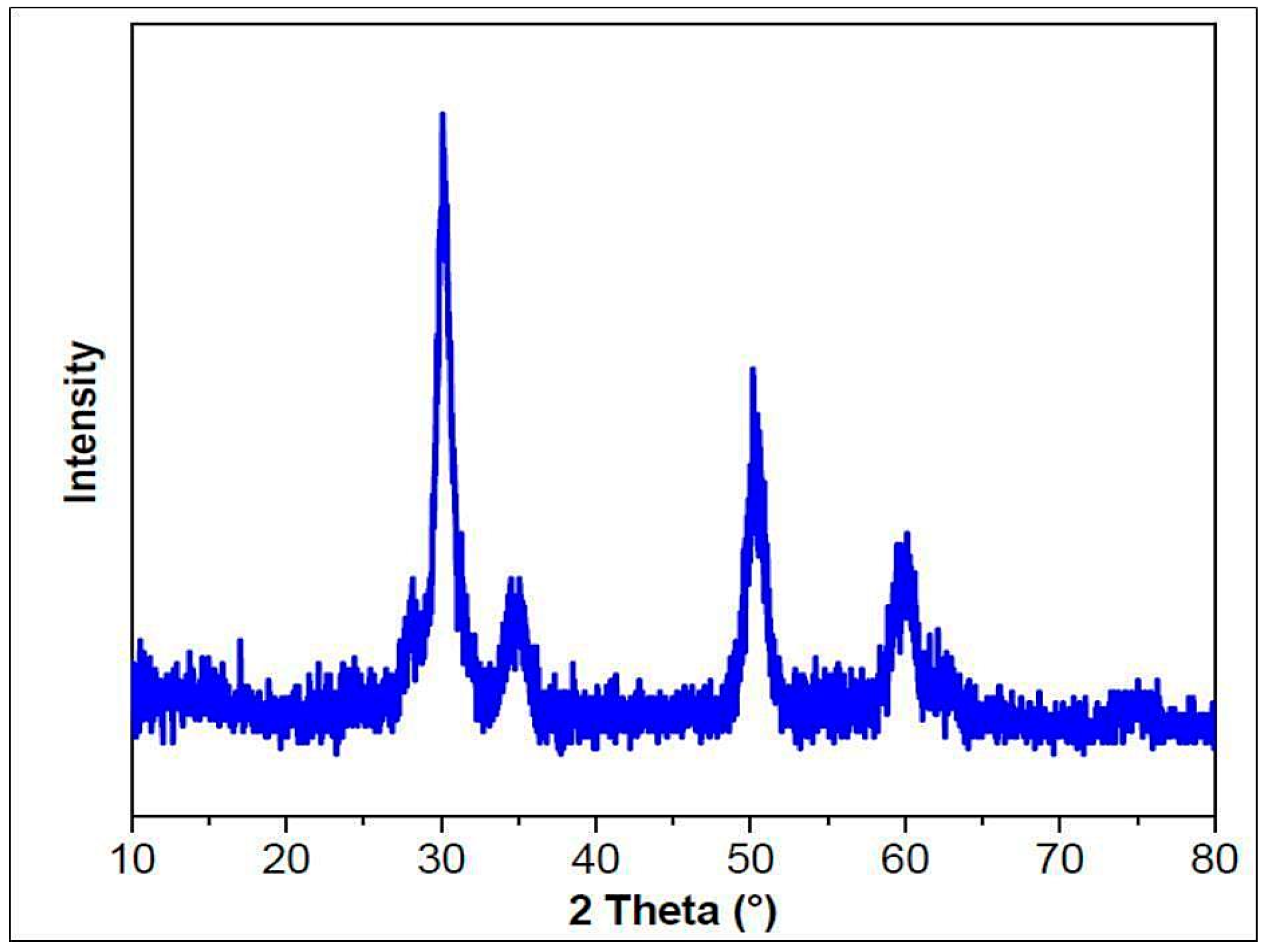
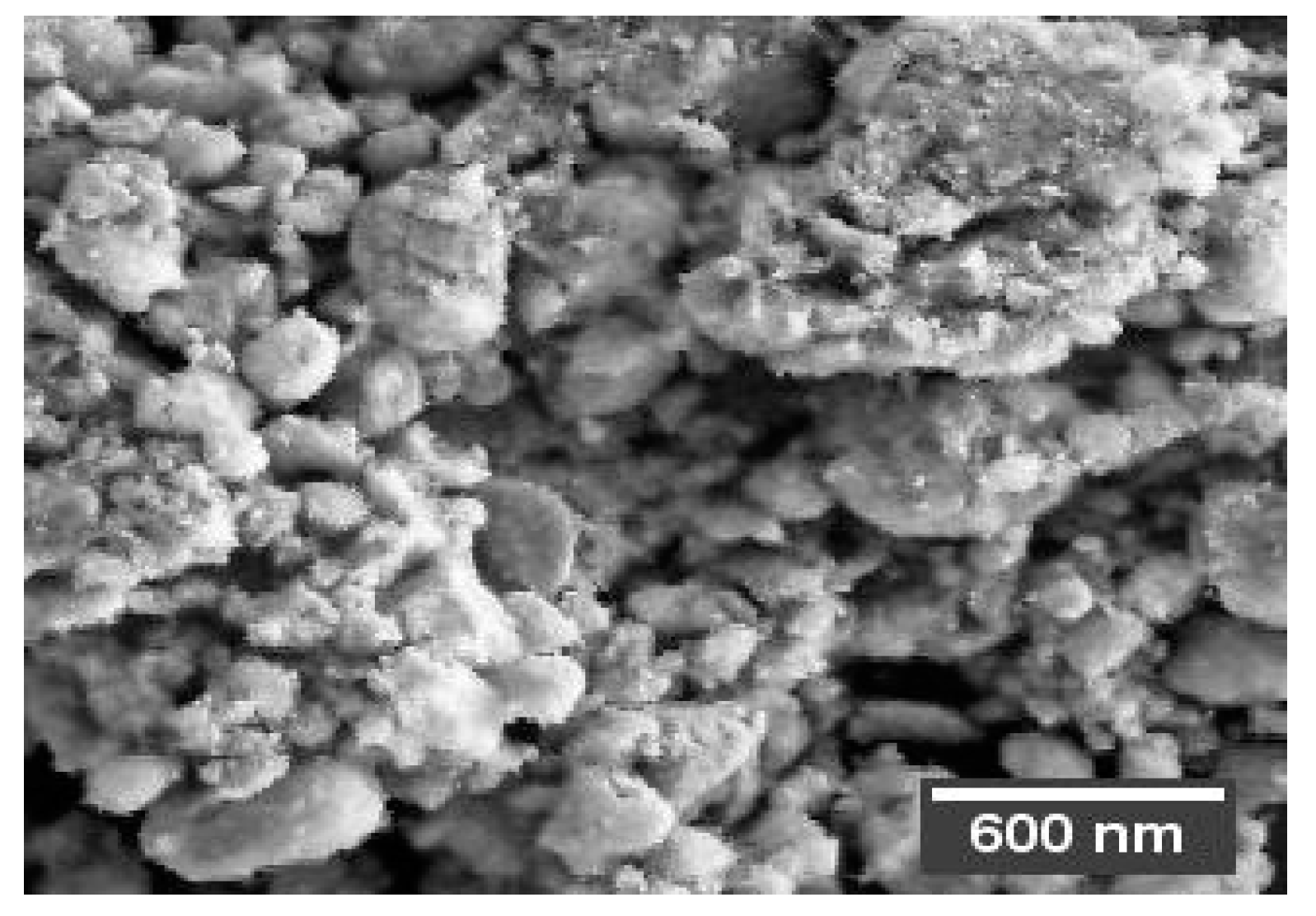
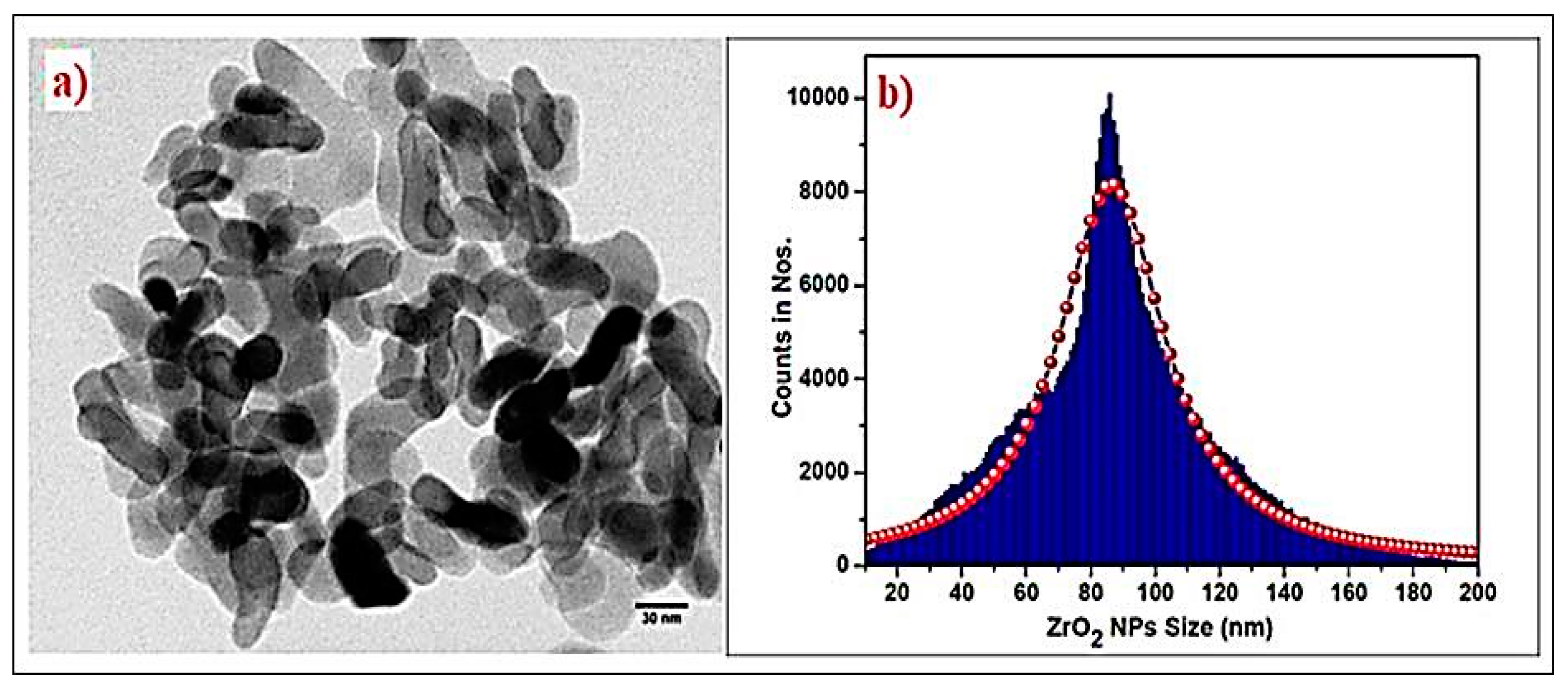
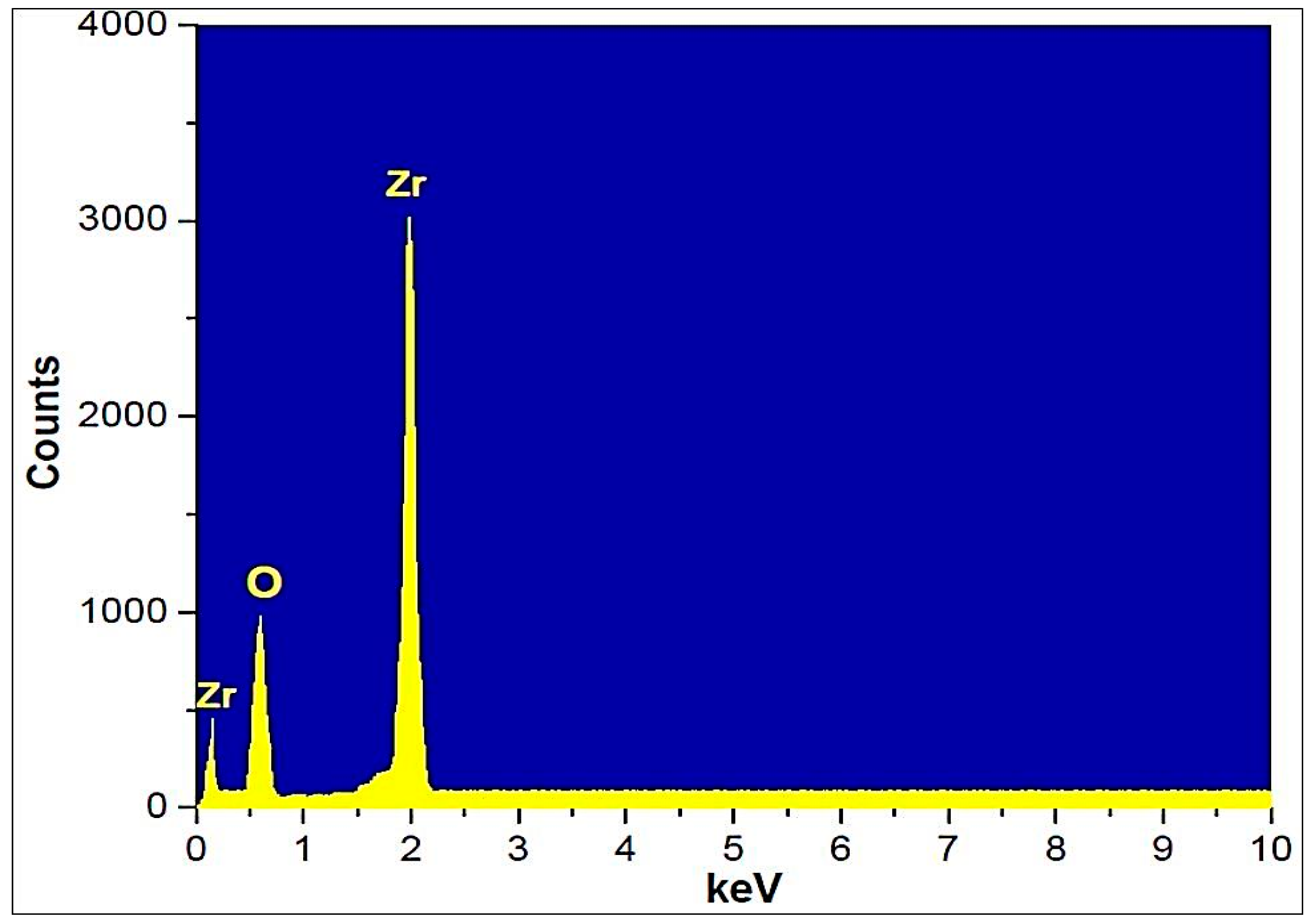

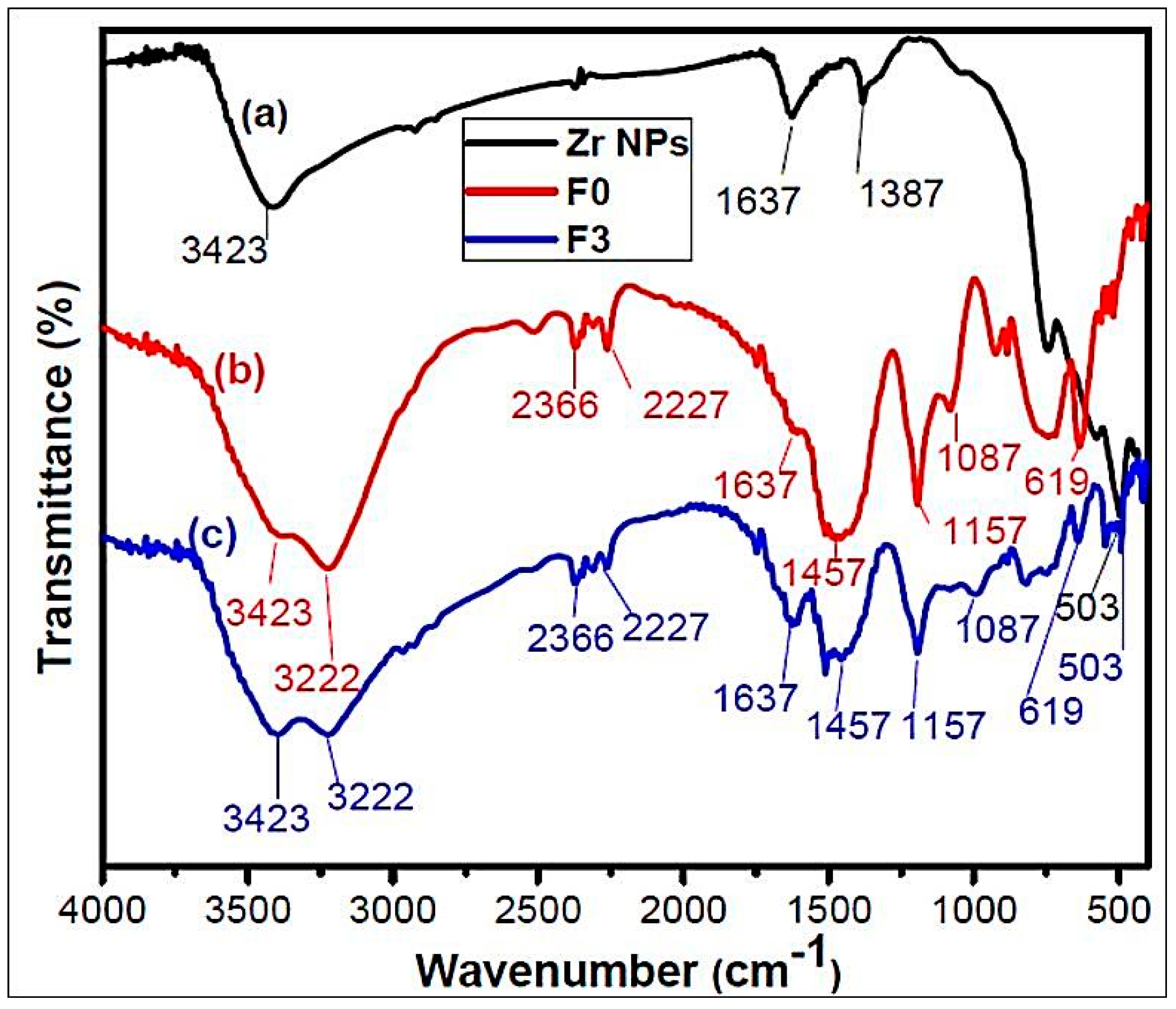
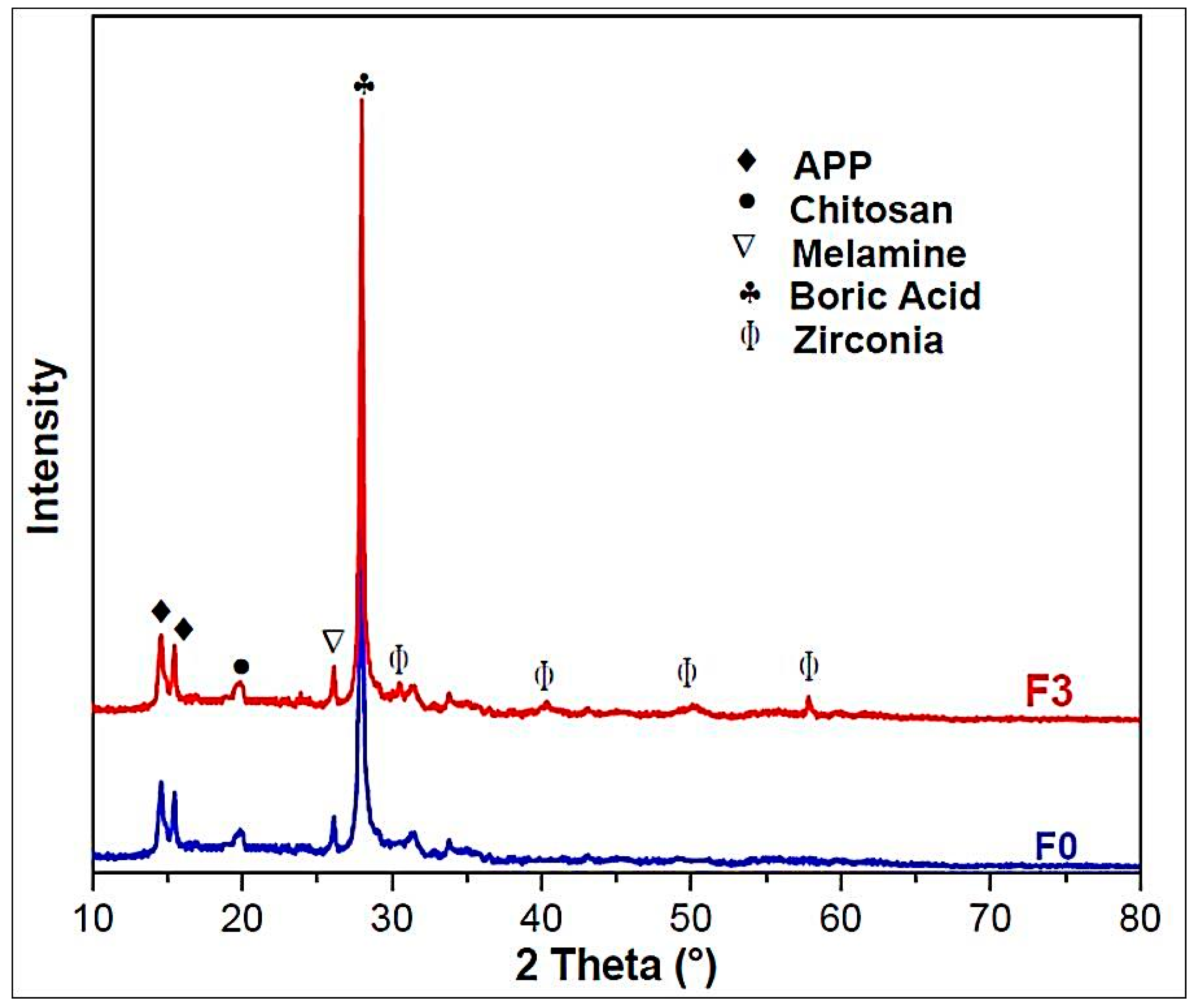
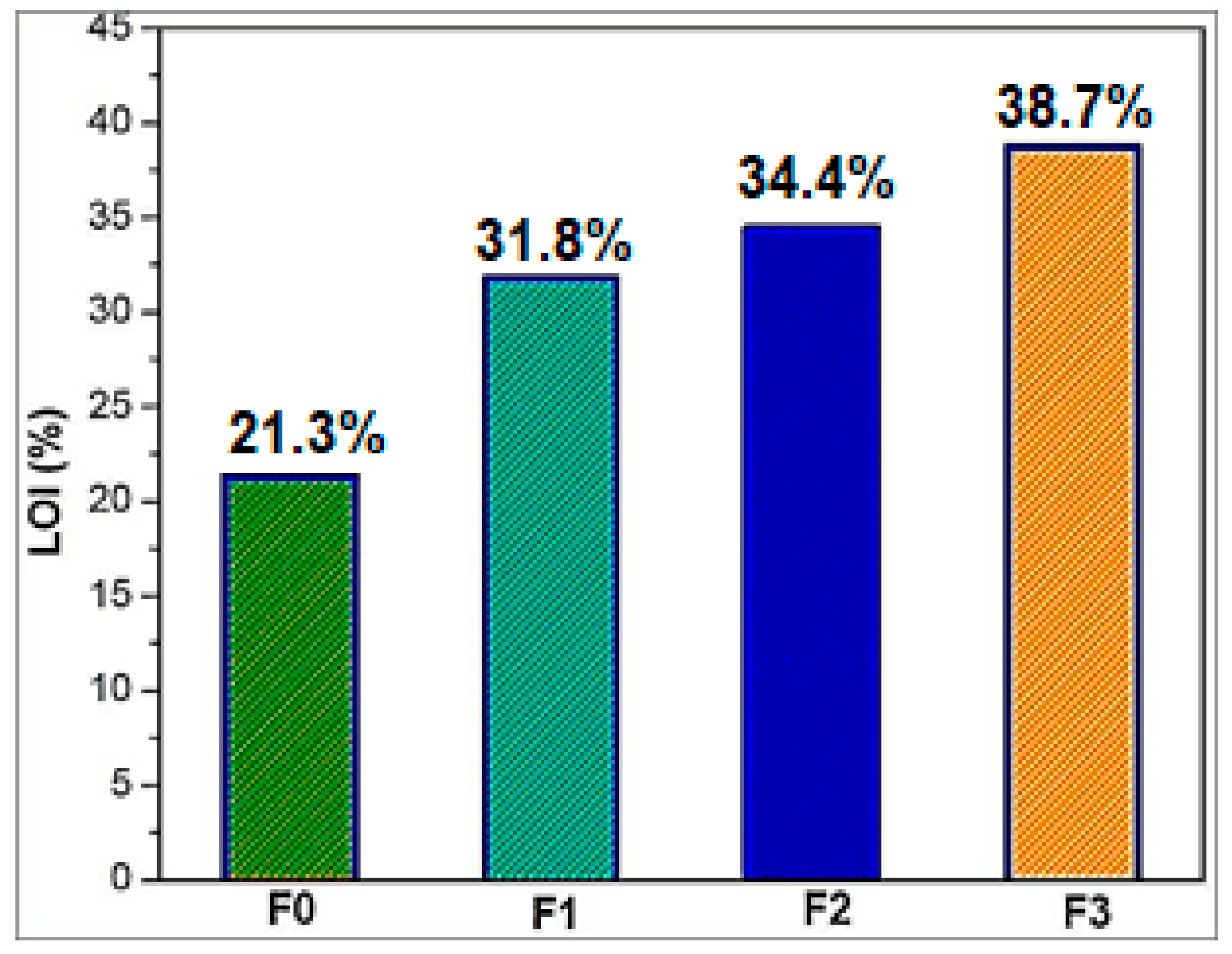
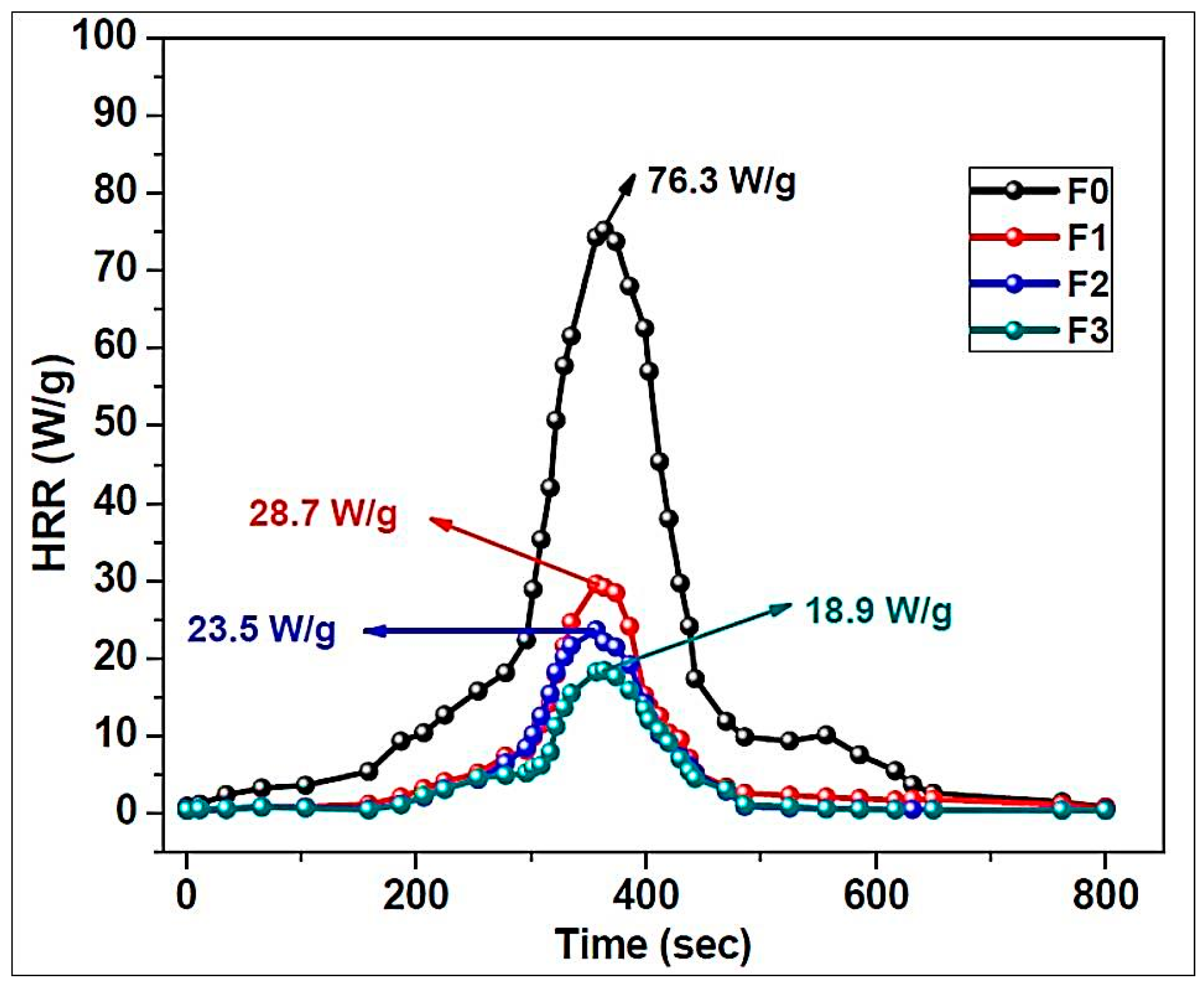
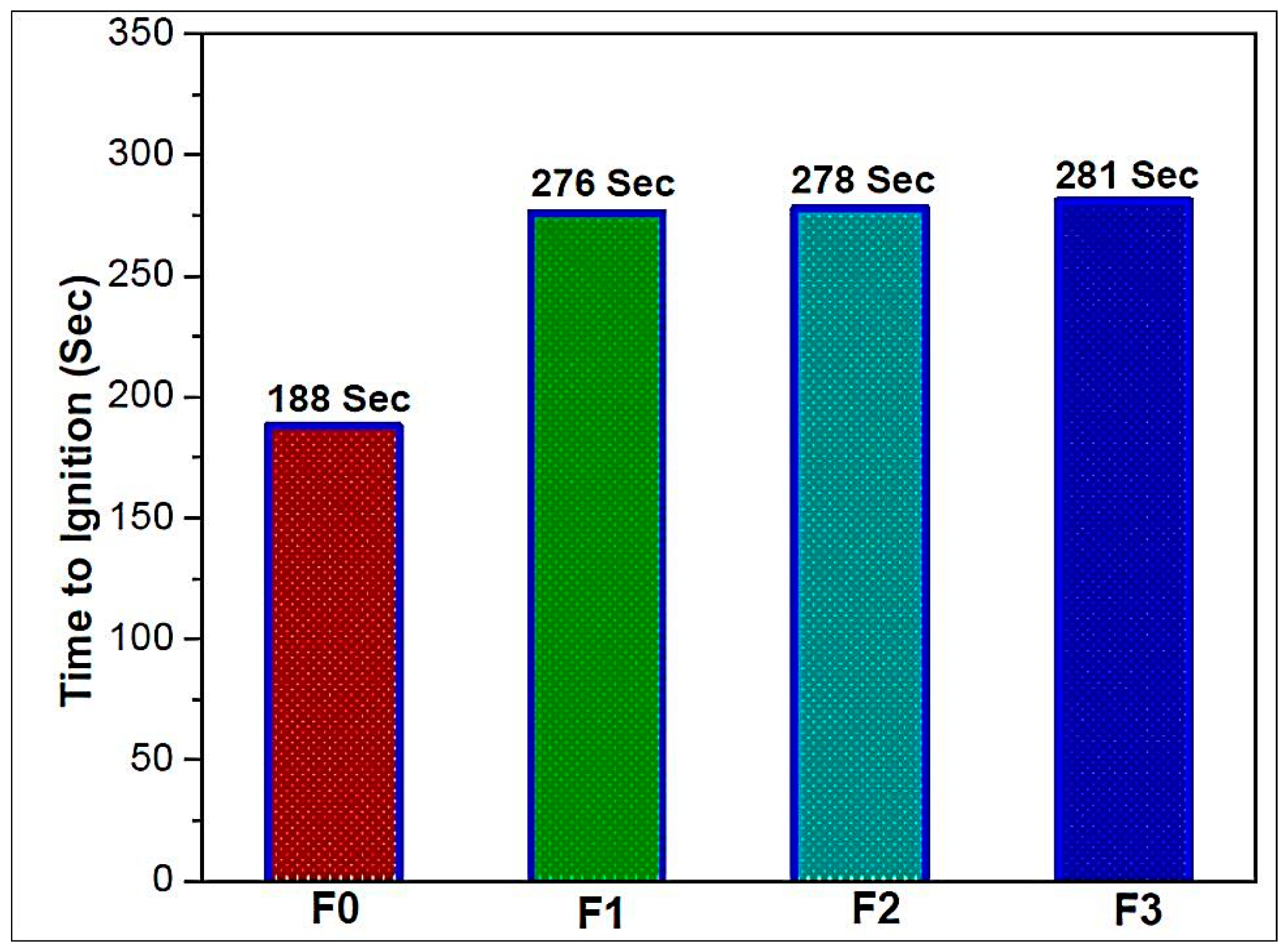
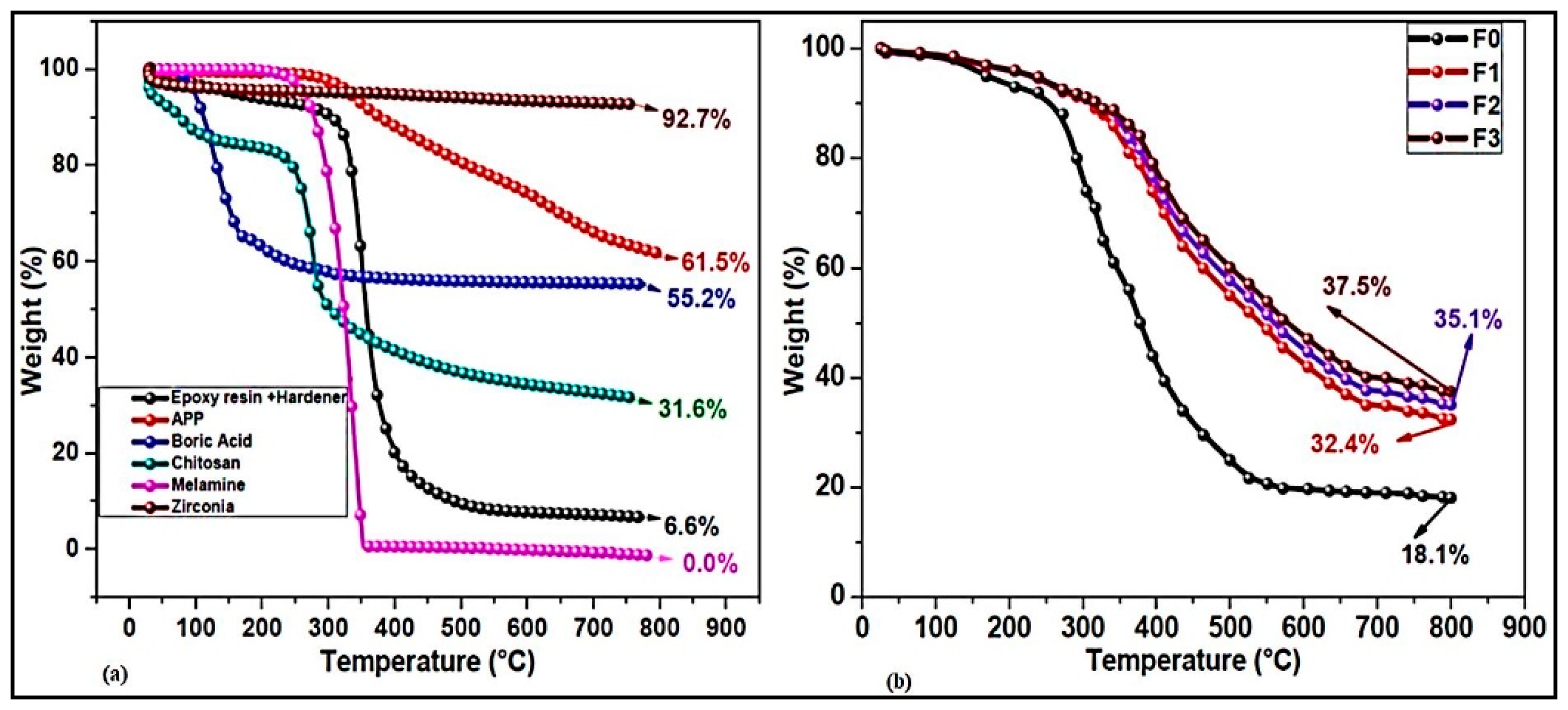
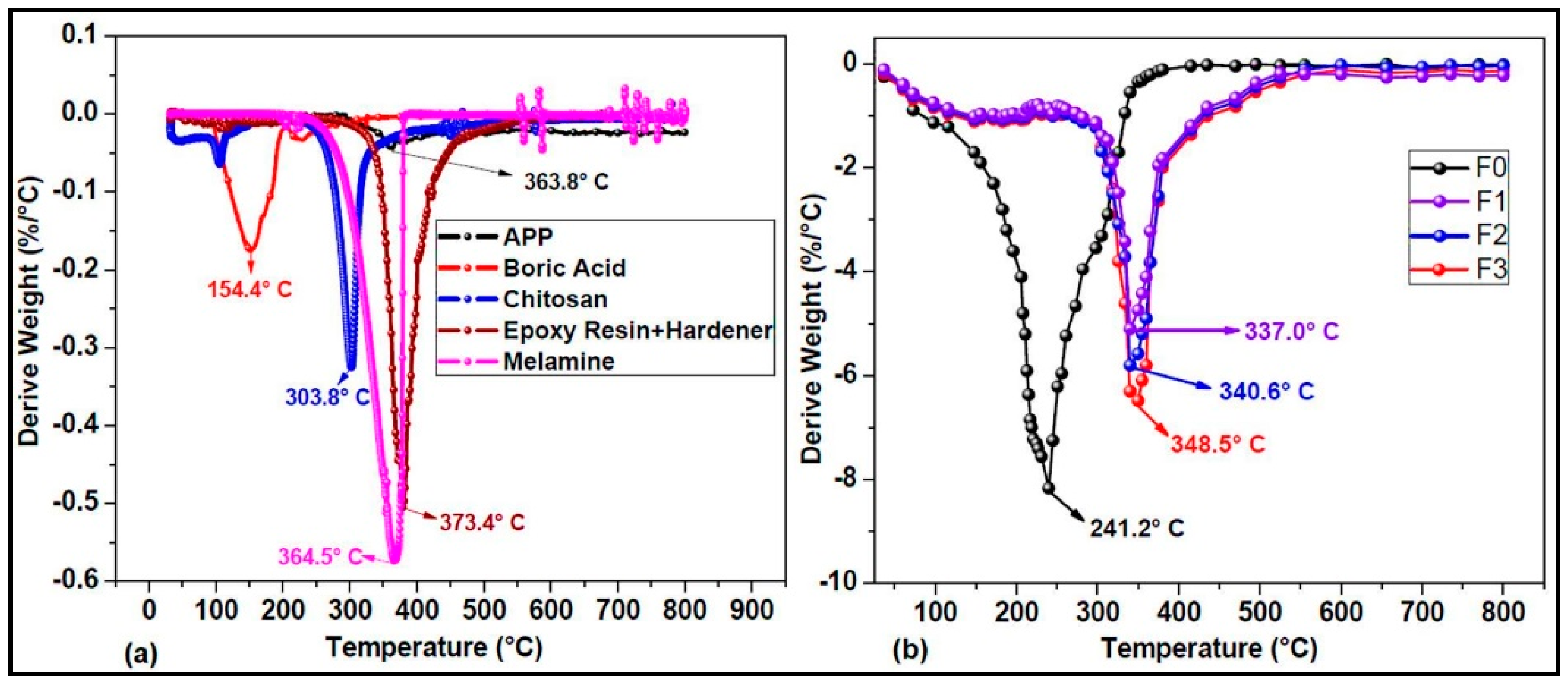
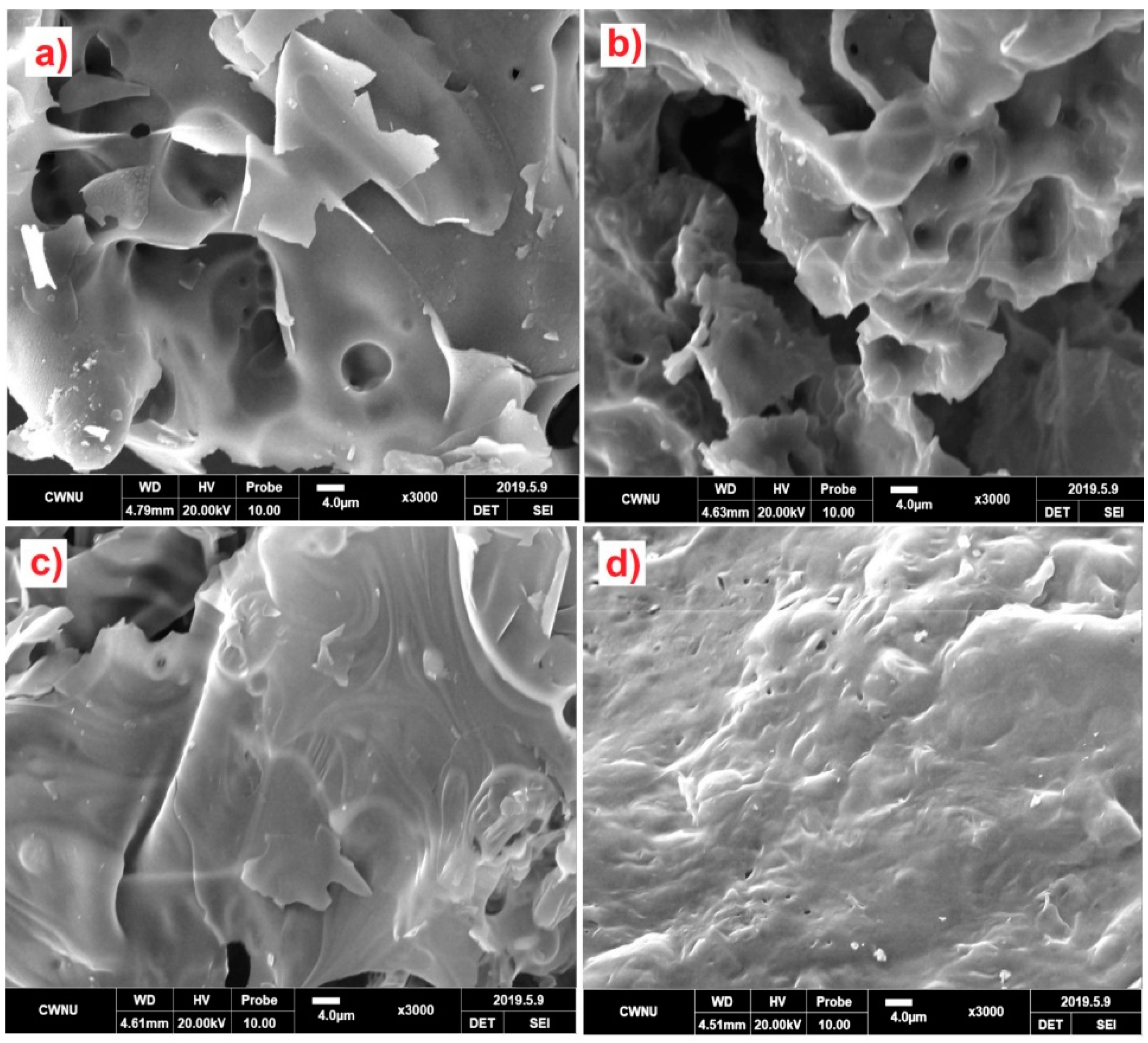
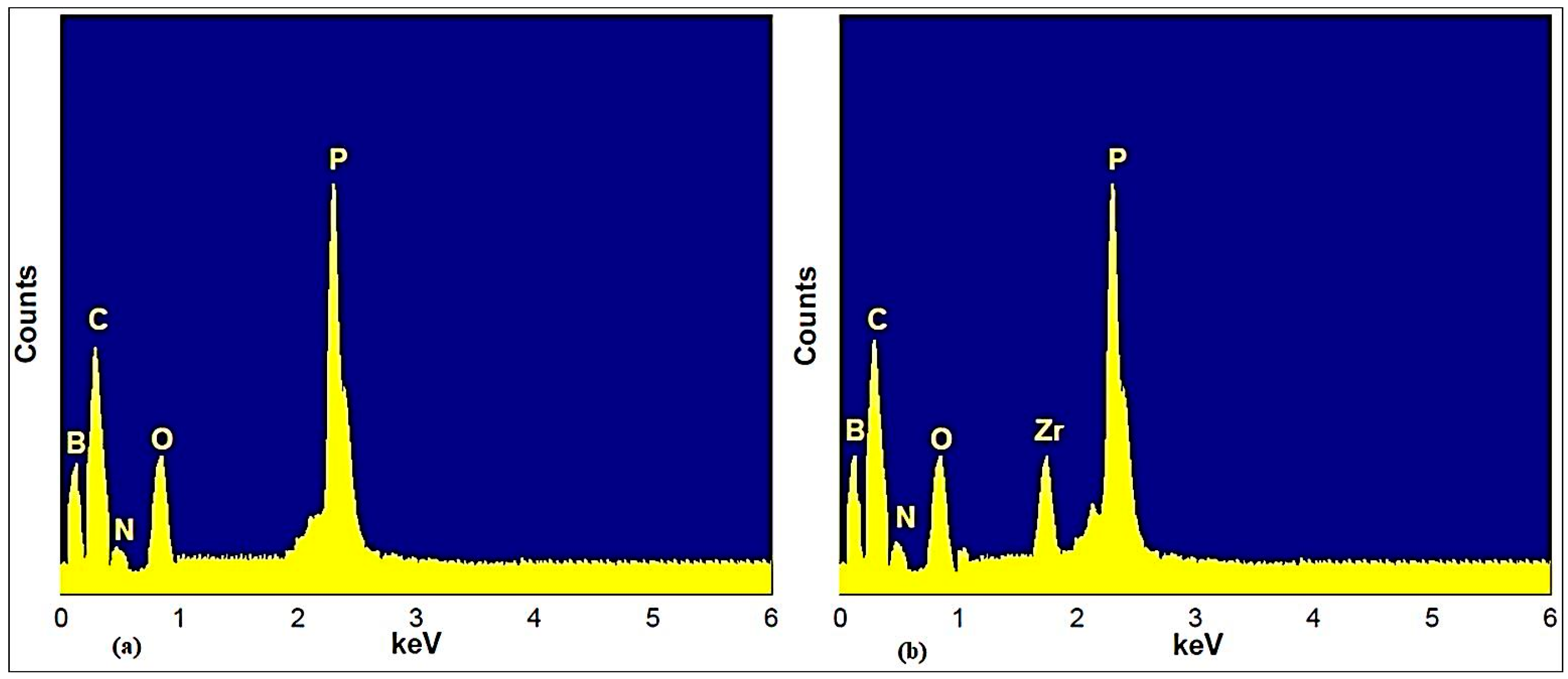
| Formulation | Ammonium Polyphosphate | Chitosan | Melamine | Boric Acid | ZrO2 NPs | Bisphenol:Hardener (2:1) |
|---|---|---|---|---|---|---|
| F0 | 15 | 5 | 5 | 15 | 0 | 60 |
| F1 | 15 | 5 | 5 | 15 | 1 | 59 |
| F2 | 15 | 5 | 5 | 15 | 2 | 58 |
| F3 | 15 | 5 | 5 | 15 | 3 | 57 |
| Code | LOI% | Rating Results |
|---|---|---|
| F0 | 21.3 | V-1 |
| F1 | 31.8 | V-0 |
| F2 | 35.4 | V-0 |
| F3 | 38.7 | V-0 |
| Formulation | TTI (sec) | PHRR (W/g) | THR (kJ/g) |
|---|---|---|---|
| F0 | 188 | 76.3 | 22.1 |
| F1 | 276 | 28.7 | 7.0 |
| F2 | 278 | 23.5 | 5.5 |
| F3 | 281 | 18.9 | 3.7 |
| Code | Decomposition Temp.≈ (°C) | Char Residue (%) at 800 °C |
|---|---|---|
| APP | 363.8 | 61.5 |
| Boric Acid | 154.4 | 55.2 |
| Chitosan | 303.8 | 31.6 |
| Epoxy Resin and Hardener Mixture | 373.4 | 6.6 |
| Melamine | 364.5 | 0.0 |
| * Zirconia | - | 92.7 |
| F0 | 241.2 | 18.1 |
| F1 | 337.0 | 32.4 |
| F2 | 340.6 | 35.1 |
| F3 | 348.5 | 37.5 |
© 2019 by the authors. Licensee MDPI, Basel, Switzerland. This article is an open access article distributed under the terms and conditions of the Creative Commons Attribution (CC BY) license (http://creativecommons.org/licenses/by/4.0/).
Share and Cite
Rao, T.N.; Hussain, I.; Lee, J.E.; Kumar, A.; Koo, B.H. Enhanced Thermal Properties of Zirconia Nanoparticles and Chitosan-Based Intumescent Flame Retardant Coatings. Appl. Sci. 2019, 9, 3464. https://doi.org/10.3390/app9173464
Rao TN, Hussain I, Lee JE, Kumar A, Koo BH. Enhanced Thermal Properties of Zirconia Nanoparticles and Chitosan-Based Intumescent Flame Retardant Coatings. Applied Sciences. 2019; 9(17):3464. https://doi.org/10.3390/app9173464
Chicago/Turabian StyleRao, Tentu Nageswara, Imad Hussain, Ji Eun Lee, Akshay Kumar, and Bon Heun Koo. 2019. "Enhanced Thermal Properties of Zirconia Nanoparticles and Chitosan-Based Intumescent Flame Retardant Coatings" Applied Sciences 9, no. 17: 3464. https://doi.org/10.3390/app9173464
APA StyleRao, T. N., Hussain, I., Lee, J. E., Kumar, A., & Koo, B. H. (2019). Enhanced Thermal Properties of Zirconia Nanoparticles and Chitosan-Based Intumescent Flame Retardant Coatings. Applied Sciences, 9(17), 3464. https://doi.org/10.3390/app9173464





